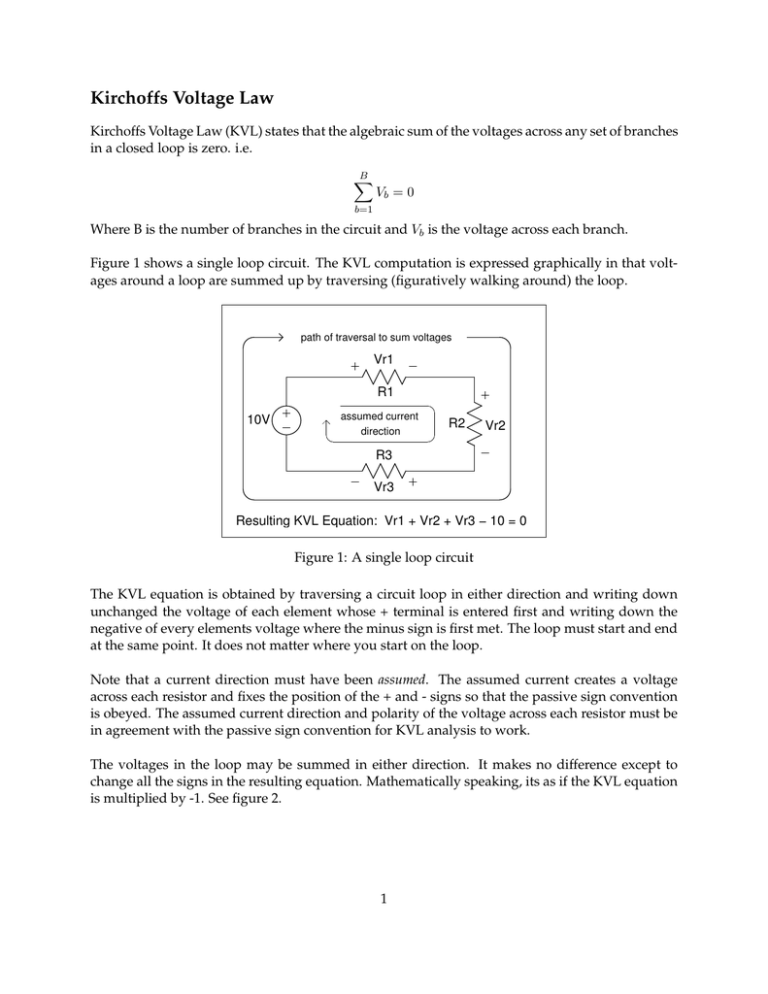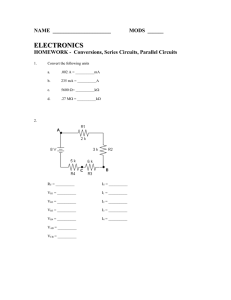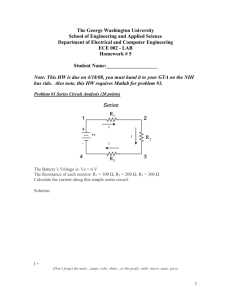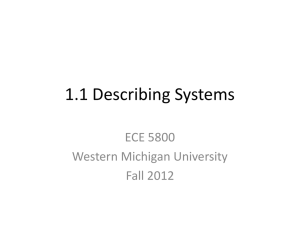Kirchoffs Voltage Law
advertisement

Kirchoffs Voltage Law Kirchoffs Voltage Law (KVL) states that the algebraic sum of the voltages across any set of branches in a closed loop is zero. i.e. B X Vb = 0 b=1 Where B is the number of branches in the circuit and Vb is the voltage across each branch. Figure 1 shows a single loop circuit. The KVL computation is expressed graphically in that voltages around a loop are summed up by traversing (figuratively walking around) the loop. path of traversal to sum voltages 10V path of traversal to sum Vr1 Vr1 R1 R1 assumed current direction R2 Vr2 10V assumed curr direction R3 R3 Vr3 Vr3 Resulting KVL Equation: Vr1 + Vr2 + Vr3 − 10 = 0 KVL equation with clockw Vr1 + Vr2 + Vr3 + Figure 1: A single loop circuit The KVL equation is obtained by traversing a circuit loop in either direction and writing down path of traversal to sum unchanged the voltage of each element whose + terminal is entered first and writing down the Vr1 negative of every elements voltage where the minus sign is first met. The loop must start and end at the same point. It does not matter where you start on the loop. R1 Note that a current direction must have been assumed. The assumed current creates10V a voltage across each resistor and fixes the position of the + and - signs so that the passive sign convention is obeyed. The assumed current direction and polarity of the voltage across each resistor must be in agreement with the passive sign convention for KVL analysis to work. assumed curr direction R3 Vr3 The voltages in the loop may be summed in either direction. It makes no difference except to change all the signs in the resulting equation. Mathematically speaking, its as if the KVL equation KVL equation assuming cloc is multiplied by -1. See figure 2. Vr1 + Vr2 + Vr3 + 1 path of traversal to sum voltages Vr2 3 Vr2 − 10 = 0 10V path of traversal to sum voltages Vr1 Vr1 R1 R1 assumed current path of traversal to sum voltages direction R2 10V Vr2 assumed current path of traversal to sum voltages direction Vr1 R3 Vr1 R3 R1 Vr3 R1 Vr3 current 10VKVL equationassumed with clockwise summation: R2 Vr2 direction Vr1 + Vr2 + Vr3 + 10 = 0 R3 R2 Vr2 current 10V KVL equation assumed with counterwise summation: R2 Vr2 direction −Vr3 − Vr2 − Vr1 + 10 = 0 R3 Figure Vr3 2: Voltage summation can be done in either direction Vr3 path of traversal to sum voltages − 10 = 0 path of traversal to sum voltages KVL equation with counterwise summation: KVL equation with clockwise summation: The case on the right ofVr1 figure 3 will obviously result in negative result Vr1 for the current. This is −Vr3 − Vr2 − Vr1 + 10 = 0 Vr1 + Vr2 + Vr3 + 10 = 0 correct considering the current arrow is pointing in the opposite direction. R1 10V 10V assumed current path of traversal to sum voltages direction R1 R2 10V Vr2 assumed current path of traversal to sum voltages direction Vr1 R3 Vr1 R3 R1 Vr3 R1 Vr3 assumed current direction 10V R2 Vr2 assumed current direction R2 Vr2 KVL equation assuming clockwise current flow: R3 + − 10 = 0 Vr1 + Vr2 + Vr3 R2 Vr2 KVL equation assuming counter clockwise current flow: −Vr1 − Vr2 R3 − Vr3 − 10 = 0 Vr3 Vr3 KVL equation assuming clockwise current flow: Vr1 + Vr2 + Vr3 + − 10 = 0 KVL equation assuming counter clockwise current flow: −Vr1 − Vr2 − Vr3 − 10 = 0 Figure 3: The assumed current direction fixes the voltage references TITLE FILE: PAGE REVISION: OF DRAWN BY: TITLE FILE: PAGE 2 REVISION: OF DRAWN BY:



